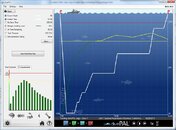The idea of tissue compartments goes back more than 100 years. Different theorists have different numbers of compartments. Here is a quick and overly simplified summary.
When nitrogen is absorbed into the body, the rate at which it is absorbed and later released varies from one tissue to another. The more liquid it is, the faster; the more blood passes through the tissue (perfusion), the faster. Some tissues are called fast tissues and some tissues are called slow tissues because of this varying rate. Nitrogen is absorbed and released through a process called diffusion. The nitrogen molecules move about randomly. When you have been on the surface hanging around for long enough, the amount of nitrogen in the air you breathe and the tissues in your body is the same. That is because the random motion of the molecules has evened out--as many molecules are going into the body as you breathe as are going out. Your body is said to be at equilibrium.
When you descend to 99 feet, every lungful of air you breathe has 4 times as many molecules in it as on the surface, so there are now 4 times as many molecules going into your body as out. That difference is called a gradient. The higher the gradient, the faster your tissues absorb nitrogen. As you swim around at 99 feet, the tissues become more and more saturated with nitrogen. This lowers the gradient, so the rate at which you absorb nitrogen slows down. This slowing down is approximated by a concept called halftimes. A very fast tissue will be half way to being saturated in 5 minutes, but it will be slowing down. It will get half way from that point in another 5 minutes. Then it will be halfway from that point in the next 5 minutes. Eventually it will be saturated and have the same level of nitrogen as the air you are breathing. That will take about 6 times the amount of time it took it to get to the half way point.
When you ascend, the opposite happens. When you have more nitrogen in your tissues than the air, it will start to leave the tissues.
There are many tissues in the body, so in order to plan decompression, they could not describe then all, and a number theoretical tissues were created instead. These are sometimes called compartments. They do not correspond to specific tissues but to a range of tissues that are similar. The tissues mentioned above that get half way to saturation in 5 minutes are said to have a 5 minute half time. That is sometimes called the 5 minute compartment.
The purpose is to help calculate how much nitrogen has entered the body and what needs to be done to get it out safely.





